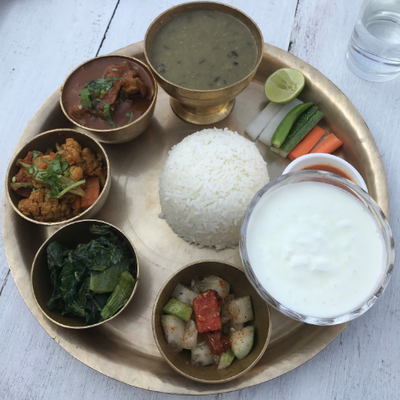Food
All about pork
For a restaurant that is apparently for sale, Noyoz delivers decent eastern Nepal-style food at a reasonable price point..jpg&w=900&height=601)
Hantakali
The first thing you see when you enter Noyoz is the writing on the wall—a sheet of paper that says ‘Restaurant on sale’. Accordingly, there’s an unshakeable feeling of abandonment. Paint has peeled from some sections of the walls, and except for a few bottles of vodka and whisky, the liquor rack at the bar is desolate. The feeling of neglect is further buttressed by the fact that, except for our table, the restaurant is all but empty.
Having dined at this Baluwatar-based restaurant for the first time in early 2017, followed by a few visits in quick succession, Noyoz’s interior has never been impressive. But it sure didn’t look this dejected. Back then, the establishment had earned itself quite a reputation for its pork dishes. With a pig on its logo, the restaurant has always made its meat leanings quite apparent. I remember leaving the restaurant after each visit quite satisfied with the experience.
But does the fact that the restaurant is now on the verge of closure mean that my experience would be different this time around? We spend some time mulling over whether we should go somewhere else, but in the end, we decide against it.
As we sit down in the empty restaurant and scan the menu, it’s evident that not much has changed—the menu still fits on an A4 page and the prices continue to be quite reasonable. We place an order for sargemba and the server is quick to inform us they don’t have it. We move on and order other dishes—almost all of them pork. If this is the last time I’m going to have a meal at Noyoz, I wanted to go out stuffed with pork.
The first dish, smoked pork, takes forever to come. But when it arrives, it comes accompanied by a wafting, irresistibly smoky aroma. The pork pieces are decent-sized chunks glazed in oil and sauce. Sitting side by side are pallid boiled vegetables, represented by unseasoned potatoes that crumble at the slightest press of a spoon, carrots, and French beans. The dreary vegetables only make the pork appear more appetising, but alas, the meat has an unpleasant acridness that is off-putting. Perhaps the chef smoked the pork a tad too long, which has led the meat to become chewy and dry.
.jpg)
By the time our table finishes the smoked pork, guests start trickling in. A young couple and two women walk in, one of whom proceeds to rave about how good the smoked pork at the restaurant is, managing to convince her friend to order it. The restaurant is suddenly stripped off its desolate feel.
Then, the pork leg curry arrives. There’s a choice of rice or roti and we’ve gone with the former. Popularly known as pork khutti, the curry is a gelatinous mix of almost three fist-sized dollops of different parts of porcine leg in a thick gravy. The khutti looks akin to similar offerings from numerous restaurants serving eastern Nepal-influenced cuisine. But what is completely unfamiliar is the mild seasoning, which ends up making the dish rather bland. Even though the meat is cooked to perfection and pulls off the bone, and the fat leaves a comforting coating inside the mouth, it is the lack of flavour that sticks out, leaving this table wanting more seasoning.
After two not-so-remarkable dishes, I begin to wonder if I was too naive to hope for a glorious meal at a restaurant on the verge of being sold. Even though we are only two dishes, out of five, down, I am already feeling a bit of a fool.
When the pork dameko arrives, it puts all my fears at rest. The server attending to our table tells us that the pork is first steamed and then fried. Unlike the smoked pork, which had large chunks, the pork dameko has thinly sliced meat freckled with spices. They also give you coins of carrot to go along with the dish. But let’s get back to the pork. The skin is slightly burnt, which gives it a crispy texture, and the fat and the meat are both juicy. Ask for the restaurant’s red chilli paste to dip the pork into. The combination is perfect and I wouldn’t mind coming back to the restaurant (if it remains open) just for this dish.
.jpg)
Another dish that hits all the right notes is the aloo dum. It not only looks enticing, with the potatoes clothed in a thick gravy and topped with fresh coriander leaves and speckled with deep-fried fenugreek seeds, but smells inviting too. At the base of the plate is a tiny pool of oil. The potatoes are cooked to perfection and the fenugreek seeds add a crackle of bitterness that is enough to tease the palate. The gravy is comforting and goes excellently with the chapati-style roti served alongside.
The last dish to arrive is the pork momo. The momo wrappers are thin and the meat is mildly spiced and juicy. It’s not one of the best eastern-style momos, but it is definitely not the worst.
As we leave Noyoz, I remember the same feeling I had when I first dined here almost two years ago. Are there better restaurants in the city that serve similar fare? Yes, but they are also more expensive. Reasonable prices, generous portions, a location in an upscale neighbourhood—midway between Baluwatar and Bhatbhateni—and decent food are Noyoz’s specialities. But, if the writing is truly on the wall for this restaurant, those who have been here will certainly miss it.
What we ate
Pork dameko: Rs 290
Alu dum and roti: Rs 210
Pork leg curry with rice: Rs 275
Smoked pork: Rs 330
Chicken momo: Rs 200
Noyoz Rs 140 to Rs 350 per person
Food: ★★
Ambience: ★★
Value: ★★★




 8.12°C Kathmandu
8.12°C Kathmandu











